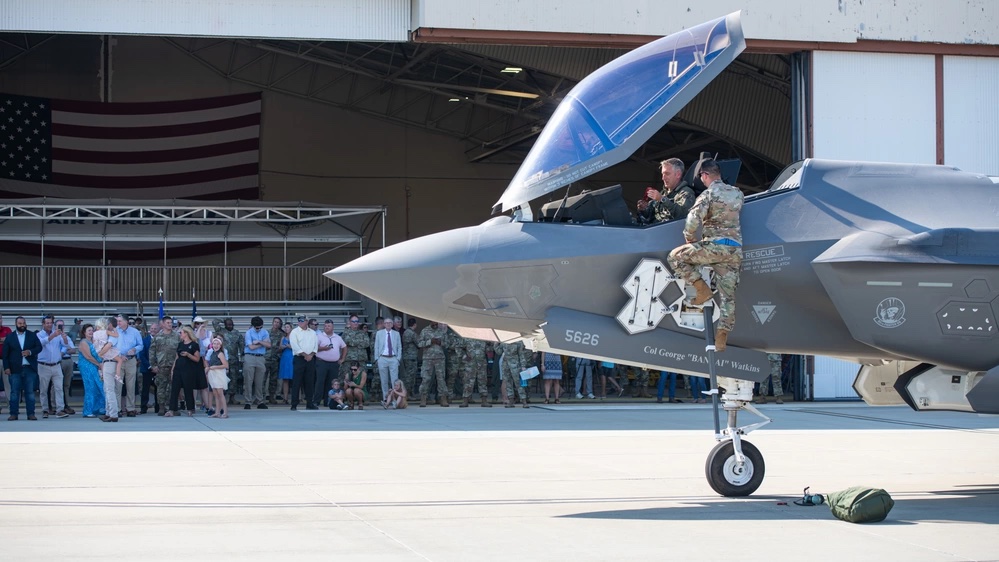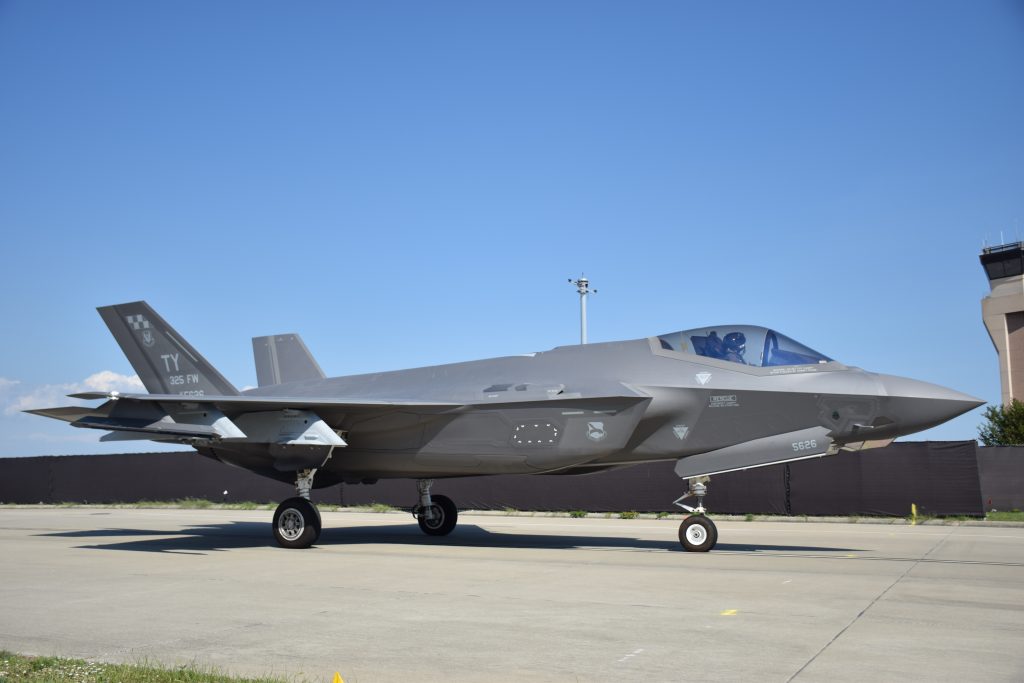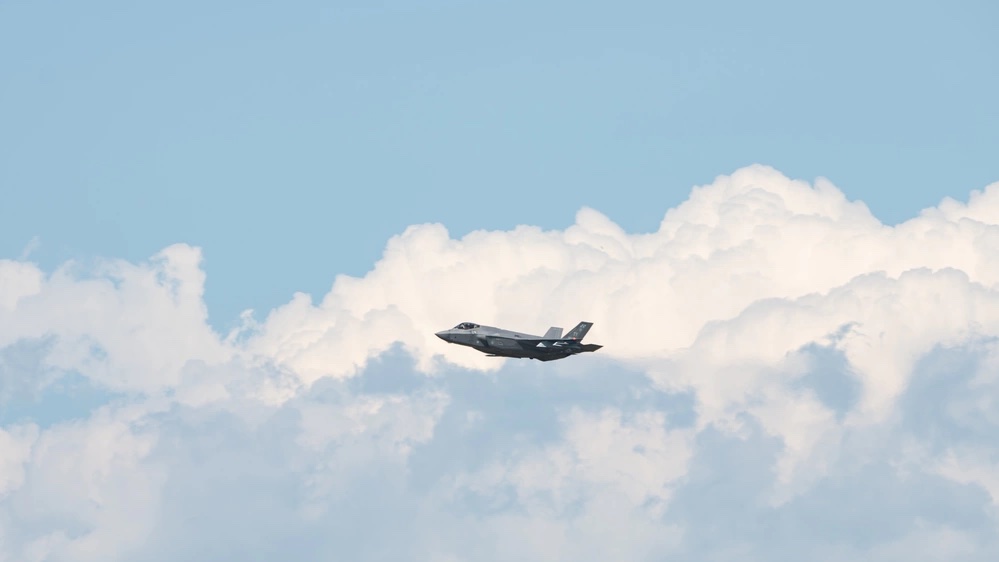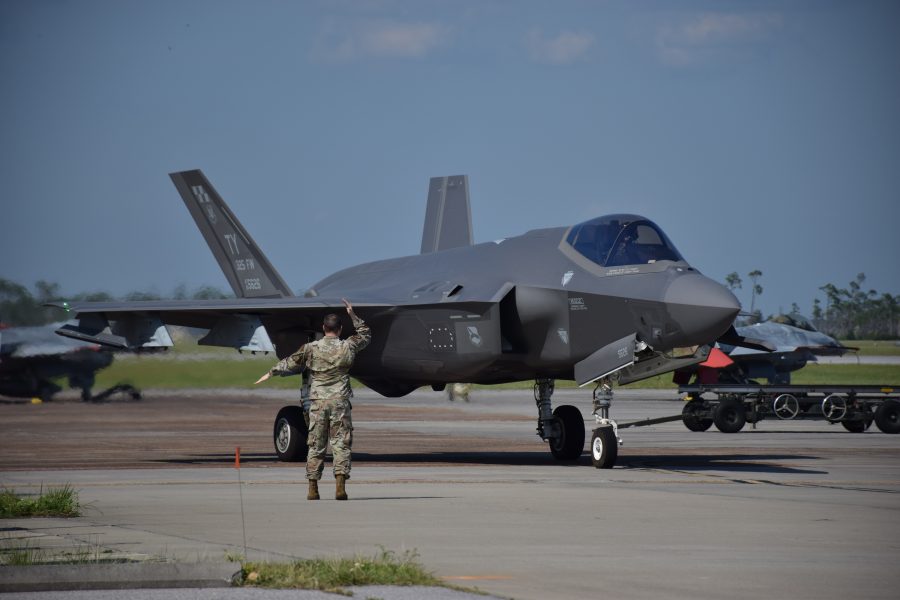TYNDALL AIR FORCE Base, Fla.—The first three F-35 fighter jets assigned to Tyndall Air Force Base, Fla., arrived there Aug. 1 after a cross-country flight from Luke Air Force Base, Ariz., and a stop for gas in Fort Worth, Texas, marking a historic milestone for the base, which, five years after being leveled by Hurricane Michael, is transitioning from an F-22 pilot training base to a centerpiece for the Air Force’s operational F-35 enterprise.
The jets are assigned to Tyndall’s historic 95th Fighter Squadron, which reactivated in June after a four-year hiatus. A fourth F-35 arrived Aug. 3, making a four-ship for the ‘Boneheads,’ a nickname which dates back to World War II.
“I was able to look to my right and see the two other F-35s with the tails painted in the Tyndall checker pattern, and then I looked to my left and I could see Tyndall, Panama City, and the airfield,” Lt. Col. Hunter Powell, commander of the 95th Fighter Squadron and one of the three pilots who flew in on Aug. 1, told Air & Space Forces Magazine. “That was when you kind of realize ‘this is a big moment.’”

Barring further F-35 production delays, the 95th plans to grow to 16 aircraft by the end of summer 2024 and reach its full operational capability with 24 primary assigned aircraft and two more in reserve by the middle of 2025. Two other squadrons of equal strength will round out the 325th Fighter Wing, making Tyndall the first base in Air Combat Command where the host unit is an operational F-35 wing. That arrangement will make Tyndall a one-stop shop for deploying F-35s downrange as part of the Air Force’s new force generation model, AFFORGEN, where pilots, aircraft maintenance, command and control, and base support elements deploy together overseas.
“This is the Air Force’s vision for how we deploy in the future,” said Col. George Watkins, commander of the 325th and another of the three pilots to bring Tyndall’s first F-35s home Aug. 1. “This team trains together, day in and day out, and then deploys together to go set up a wing somewhere, instead of individual units sending squadrons and falling in under a different commander that no one’s ever met.”
Though the wing is far from full strength, the 95th can still sharpen its skills with the aircraft it has on hand. Over the next few months, pilots will practice basic fighter maneuvers, basic surface attack, and suppression of enemy air defenses (SEAD). The squadron received its first surface-to-air missile threat emitter late last month, an Expendable Low-cost Integrated Training Emitter (ELITE) that will be put to good use helping pilots prepare for their “bread-and-butter” SEAD mission, Powell said.
In the wake of Hurricane Michael and with Tyndall having previously been a primarily air-to-air focused base, the 325th will have to develop electronic warfare ranges in order to put on robust SEAD exercises. The wing expects to receive more threat emitters over the next few months to start making those ranges a reality.
“We joke that we have the entire range in our office right now,” Powell said, referring to the lone ELITE already delivered.
Tyndall can fly the basics for now, but “the more jets you can fly at a time, the better it is for advanced tactics,” Watkins explained. Luckily, there are plenty of nearby units to help. Just 90 miles west of Tyndall lies Eglin Air Force Base, which hosts the F-35-equipped 33rd Fighter Wing. More F-35s are also due to arrive at the Alabama Air National Guard base in Montgomery and the Florida Air National Guard base at Jacksonville. Tyndall also hosts major annual fighter exercises such as Checkered Flag, Weapons System Evaluation Program-East (WSEP), and Combat Archer.
“What pushes us over the edge of success here are the integration opportunities,” Powell said. “That integration turns our four-ship into 12, 16, 24 ships of awesome high-end training.”

Still, there may be challenges ahead as the F-35 presence grows at Tyndall. The 325th Fighter Wing does not want to end up with many more pilots than aircraft at the base, which would limit opportunities to fly. But personnel management plans can be disrupted when F-35 deliveries are delayed due to production issues.
“When the jets get delivered or whether any modifications are needed, those are all things that are outside of our control,” Powell said. “If one of our assumptions changes on the aircraft side, then we have to go back and re-calculate what we want to do [on the personnel side], but some of those personnel wheels can’t be turned off.”
The balancing act is a challenge, but “that’s part of the nature of the beast,” he said. “It is what it is.”
Another challenge is scheduling: while the training airspace over the Gulf Coast is massive, staking flight time for all the various military aviation units that share it may take some doing as more F-35s arrive at Tyndall.
“I won’t say there’ll be zero pain points, but that comes with the territory,” said Col. Chris Bergtholdt, commander of the 325th Operations Group. “We’ve got a process and everybody works through what the priorities are for that month.”
An F-15 and F-22 pilot, Bergtholdt flew one of Tyndall’s few remaining Raptors to its new home at Joint Base Langley-Eustis, Va., late last month. The colonel is a product of the 43rd Fighter Squadron, the only formal training unit for the Raptor community, which has put down roots in the Florida Panhandle over its years at Tyndall and then at Eglin in the wake of Hurricane Michael. Seeing it move to Virginia, which will be the new home of F-22 training, is bittersweet.
“Every Raptor pilot to this point had gone through that squadron,” said Bergtholdt, who will learn to fly the Lighting II in a few weeks. “It’s certainly sad to see that mission leave the Panhandle … but the F-35 is a great aircraft and it’s great to bring flying back here to Tyndall.”

Unlike other F-35 units standing up across the Air Force, Tyndall has the additional challenge of being in the middle of a sweeping reconstruction effort after Hurricane Michael. Under a plan known as ‘Installation of the Future,’ the Air Force seeks to rebuild the base so that it can withstand future Category 5 hurricanes and be safer, stronger, and more efficient than before.
The plan includes state-of-the-art combination hangar/headquarters for each of its three F-35 squadrons, but those are not expected to be finished until 2026. In the meantime, the squadron will work out of temporary facilities while negotiating congestion, construction, and a lot of paperwork. Besides jets and pilots, fighter squadrons also need pens, pencils, warehouses full of spare parts, containers for taking those spare parts on a deployment, computers, paper shredders, and myriad other tools and materials.
“There are all these little nuts and bolts and that takes a lot of work to prioritize, shop on these government equivalents of an Amazon list, and then supply your squadron,” Powell said.
The work adds up, but wing members are excited to help write a new chapter in the history of Tyndall and the wider F-35 enterprise.
“Every day is a milestone,” Powell said. “We’re under a lens in a good way: everybody is looking at the great things we are doing, and everything we do is a big growth step.”
Watkins, who once had a similar role as Powell while leading Hill Air Force Base’s 34th Fighter Squadron as it transitioned to F-35s in 2015, held the same view.
“It’s the people who make the culture and the people who make the Installation of the Future,” he said. “So even though our facilities are going to be Hurricane 5-rated and our jets are going to be top of the line, I’m really excited to see where our Airmen take us.”

